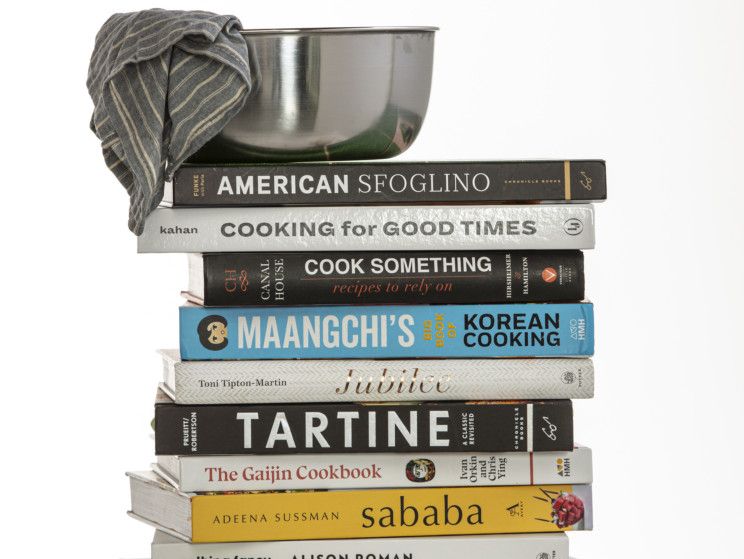365: A Year of Everyday Cooking & Baking’
To live a year in Meike Peters’ life! In ‘365’ (Prestel, $40), Peters, who won a James Beard award for her 2016 book, ‘Eat in My Kitchen’, offers a meal for every night from January to December. The recipes are largely European in focus (Peters lives in Berlin and Malta), skew seasonal and, rare for a cookbook, tend to serve two. There’s some repetition, but isn’t that real life, where sometimes you’re eating alone, or making variations on a favourite dish? Weekends are earmarked for more time-consuming recipes: cakes and tarts, cookies and jam. Dinner, they’re not. But sustenance for the week ahead? Definitely.
‘Ama: A Modern Tex-Mex Kitchen’
What happens when Tex-Mex finds a home in Southern California? In Josef Centeno’s new cookbook, ‘Ama’ (Chronicle, $29.95), the results are sunny and delicious, from a vegan, cashew-based “queso” built on the flavours of charred onion, garlic and green chili, to a simple halved ruby red grapefruit, broiled with a topping of butter and piloncillo sugar, just like his auntie used to do. Centeno, a San Antonio native, and writer Betty Hallock have published a rare cheffy cookbook, with the kind of approachable recipes a home cook might want to try — even if they’ve never had the chance to eat at his excellent restaurants in Los Angeles.
‘American Sfoglino: A Master Class in Handmade Pasta’
Like any proper sfoglino — the Italian term for a person dedicated to the art of fresh pasta making — Evan Funke has mastered the craft of making fresh pasta to the point at which he can cook by his senses. Thanks to his pasta manual, “American Sfoglino” (Chronicle, $35), written with Katie Parla, you can, too — but first, expect lots of talk about the “ideal gluten network,” “level of salinity” and “pursuit of perfection.” Funke studied in Bologna, Italy, before opening Felix Trattoria in Los Angeles, and while his recipes for handmade pastas are involved, there’s no machine required. The finished dishes are mostly streamlined, in keeping with his observation that “80 per cent of Italian cooking is about getting the best ingredients.” The rest revolves around treating them right, which you’ll do with ease thanks to his careful instruction and step-by-step photography.
‘Canal House: Cook Something’
Melissa Hamilton and Christopher Hirsheimer are home cooks first, even as they run a food magazine (Canal House Cooking), a photography studio and a new restaurant in rural New Jersey. All that experience makes their second book, ‘Canal House: Cook Something’ (Voracious, $35), an ideal manual for modern cooks, often revisiting a basic formula (like devilled eggs or pan-roasted chicken thighs) and amplifying it (with inventive toppings or quick pan sauces). Beyond cooking, the longtime collaborators have worked out how to eat, shop, drink and live in ways that wring the most satisfaction from the least work. Many of the best recipes from the magazine are here, so subscribers won’t need it. But anyone else, especially starter cooks, should gobble it up.
‘Cooking for Good Times: Super Delicious, Super Simple’
When most chefs tell you something is simple, it’s safe to assume the opposite. But Paul Kahan demonstrates uncomplicated cooking at its finest in his new book, ‘Cooking for Good Times’ (Lorena Jones, $35), written with Perry Hendrix and Rachel Holtzman. The chef, whose Chicago restaurant empire includes Avec, the Publican, Big Star and Blackbird, has figured out how to feed guests without fuss, by breaking down flavourful recipes — like Brussels sprouts panzanella with balsamic onions and smoked Gouda, or steak with charred radicchio — into make-ahead components for easy last-minute assembly. When dinner is done, you can dish it up in whatever order works, with whatever wine, and guarantee a good time for the cook and the company.
‘From the Oven to the Table: Simple Dishes That Look After Themselves’
Diana Henry, the award-winning cookbook author, has the busy but aspirational home cook in mind with her latest, ‘From the Oven to the Table’ (Mitchell Beazley, $29.99). Her aim was to create a collection of recipes that can be quickly prepped and then slid into the oven, so you can get on with other things. While most of the recipes aren’t breezy, many are one-pot, and ideal for a Tuesday night that you want to make more special — like a chicken, black bean and rice wonder, in which the rice soaks up the juices from the chicken thighs as they cook together. Most of the side dishes are meant to cook on the rack beneath a main dish so they emerge simultaneously, and desserts are simple yet sophisticated: A chocolate and red wine cake glossed with ganache looks like far more work than it is.
‘The Gaijin Cookbook: Japanese Recipes From a Chef, Father, Eater, and Lifelong Outsider’
There are many cookbooks out there that try to fully capture a culture’s cuisine. This is not one of them. ‘The Gaijin Cookbook’ (Rux Martin, $30), by Ivan Orkin and Chris Ying, is full of Japanese and Japanese-inspired recipes that reflect what the authors want to cook and eat, and that you’ll want to cook and eat, too. Gaijin (gai-jin) means “foreigner” or “outsider”; although Orkin, the chef and owner of Ivan Ramen in New York, lived in Japan for years, speaks the language fluently, and even opened successful ramen shops in Tokyo, he is still considered an outsider, and so is Ying. Their perspective makes Japanese food feel more attainable than a typical cookbook on the cuisine. With classics like gyoza, and additions like miso mushroom chili, this book is a guide on how to love another culture while respecting it at the same time. — KIERA WRIGHT-RUIZ
‘Jubilee: Recipes From Two Centuries of African American Cooking’
Toni Tipton-Martin’s cookbook ‘Jubilee’ (Clarkson Potter, $35) is her follow-up to ‘The Jemima Code’, an annotated bibliography of African American cookbooks. Alongside recipes for pork chops smothered in caper-lemon sauce and hot toddies, Tipton-Martin often provides a vintage version clipped from an old cookbook. Though few writers are better at using recipes as a way to look at the past, ‘Jubilee’ isn’t a history lesson. It’s a celebration of African American cuisine right now, in all of its abundance and variety, and a vital reminder that creative cooks are constantly adapting and updating it.
‘Maangchi’s Big Book of Korean Cooking: From Everyday Meals to Celebration Cuisine’
In “Maangchi’s Big Book of Korean Cooking” (Rux Martin, $35), Emily Kim — the YouTube cooking star known as Maangchi, who wrote this book with Martha Rose Shulman — presents her recipes with encouragement that radiates off the page. Tofu stews are weeknight saviours; dosirak (lunch box meals) are perfect for children; and the section on Korean Buddhist temple cuisine, with recipes learnt from nuns at a mountain temple, will delight vegans. Practical tips abound — cleaning shellfish, shelling chestnuts, reusing leftovers — and Maangchi even prepares you for grocery shopping in her upbeat, reassuring way: “The staff may not speak perfect English, but I guarantee they will be happy to see you and will assist you the best they can.”
‘Nothing Fancy: Unfussy Food for Having People Over’
With the first line of her new book — “This is not a book about entertaining” — Alison Roman announces her break with model hostesses like Martha Stewart (whose first book was titled ‘Entertaining’) and others who keep things pretty and polite. Enemy of the mild, champion of the bold, Roman offers recipes in ‘Nothing Fancy’ (Clarkson Potter, $32.50) that are crunchy, cheesy, tangy, citrusy, fishy, smoky and spicy, just like the ones she regularly contributes to The New York Times. They work, and not only for company: Labneh with sizzled scallions, squash scattered with spiced pistachios or pasta with chorizo breadcrumbs and broccoli raab could appear anytime. For dinner parties, she provides cocktail recipes, extra snacks and pep talks so urgent and encouraging that having people over for leg of lamb and tiramisu suddenly seems like a bucket-list event.
‘South: Essential Recipes and New Explorations’
The Southern chef Sean Brock is prone to diving deep into culinary rabbit holes, and thank God. His latest cookbook, ‘South’ (Artisan, $40), written with Lucas Weir and Marion Sullivan, builds on the intellectual, culinary and historical work of his 2014 book, “Heritage,” but widens the lens from the Lowcountry to the Appalachian Mountains, where he grew up. Some of the recipes, like a pan-seared chicken breast with black pepper and peanut butter gravy, are a snap to make but deliver outsize results. Others, like tomato-okra stew and sour corn chowchow, sound simple enough but require making other recipes or investing weeks of time. Even banana pudding, with its roasted banana milk, pawpaws and homemade Cool Whip, is not safe in his hands. Still, I will keep this book forever in my collection because no one cooking today is doing more to help the Southern culinary flame burn brighter.
‘Tartine: A Classic Revisited’
Elisabeth Prueitt and Chad Robertson of Tartine have grown their famed San Francisco bakery into a small empire, with branches in Los Angeles and Seoul, South Korea, and have written four cookbooks between them. Now, 13 years after the release of their celebrated first book, ‘Tartine’, they’ve gone back to their roots with ‘Tartine: A Classic Revisited’ (Chronicle, $40). It features 68 new recipes, including their beloved morning buns (a sweet roll made with croissant dough and filled with orange-scented cinnamon sugar), as well as updates to older ones to reflect current tastes. Alternative flours abound (Prueitt is gluten intolerant), and more modern flavours run through traditional pastries. The recipes can be involved, and produce absolute showstoppers, but the book is also full of more accessible classics like shortbread and brownies.













